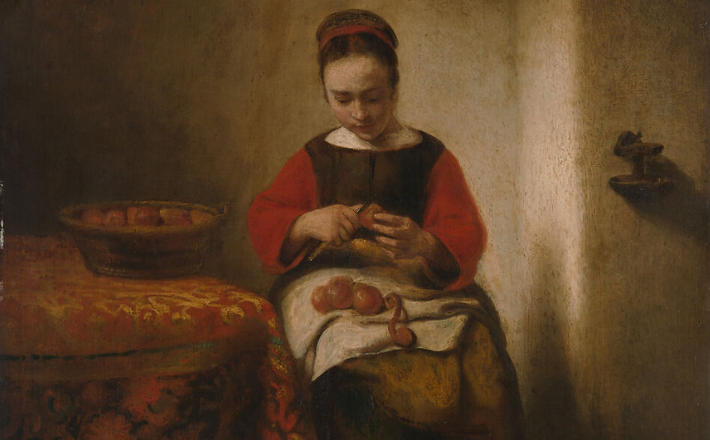Commentary on Luke 10:38-42
There is a famous legend told about Martha of Bethany that was popular in the Middle Ages. In this story, which takes place after the resurrection of Jesus, she becomes a traveling preacher and ends up in a small town in France that, unfortunately, has a chronic dragon problem. She manages to slay the dragon and, in doing so, wins the whole town over to Christianity. In that same story, her sister Mary, on that same trip, ends up starting a monastery in the wilderness, meaning they both live out the roles assigned to them in Christian history: Martha acts and Mary studies. Martha represents an active faith, while Mary represents a contemplative faith.
This dichotomy comes in many ways from Luke 10:38–42, in which Martha shows Jesus hospitality while Mary sits at his feet. The two women embody different aspects of Christian discipleship in Luke’s Gospel, and both are lifted up as positive characters. They are both doing good things. There is no villain in this story.
But ultimately, Jesus tells Martha that Mary has chosen the better part, and this represents a tension point for most readers. Why is Jesus, who has just told the parable of the Good Samaritan, now saying that sitting at his feet is the better thing to do than serving him? Does Luke think contemplative practices of Christianity (prayer and study) are really better than the active practices (hospitality and service)? Should we think that too?
To see if we can make any headway on this, let’s take a step back and look at each character’s actions.
Two good things
First, we see that Martha is described as welcoming Jesus into her home. She is showing him hospitality by receiving and preparing a meal for him. Earlier in Luke 10, Jesus tells his disciples that those who welcome them will be blessed and that the Kingdom of God has come near to them (verse 9). Similarly, in Luke 19, Zacchaeus will also welcome Jesus. Welcoming is the act of a true disciple in Luke. Martha is doing the right thing.
Her sister, Mary, is described as sitting at Jesus’ feet while listening to his words. Both actions suggest the posture of a true disciple. In the New Testament and in its wider culture, sitting at someone’s feet is a sign of deference to a teacher and indicates a teacher/disciple relationship. For instance, Paul describes himself as sitting at the feet of his teacher Gamaliel in Acts 22:3. Similarly, the theme of listening to the word of the Lord is a recurring one in Luke–Acts (Luke 5:1; 6:47; 7:29; 8:14, 21; 10:16; 11:28; 14:35; Acts 2:22; 4:4; 10:22; 13:7, 44; 15:7; 19:10; 10:28) and appears as a core piece of authentic discipleship. Thus, we have two sisters and two disciples.
The better part?
The trouble, then, is not what either sister has done. The trouble comes when we are told that Martha is distracted by many things. These distractions feel relatable as she juggles a household and serving the Lord. She then turns to Jesus and asks why he does not seem to care, and why he hasn’t asked her sister to help. Again, this feels relatable, and I think we, as readers, are supposed to sympathize with Martha in her request. She is working hard and needs help.
But by making this request, she is forcing Jesus to choose between the two (good) behaviors: either telling Mary to stop listening and help her sister, or rejecting Martha’s plea.
But Jesus flips the script on her (and on us) by telling her that she is worried about so many things, but only a few things, indeed, only one thing is needed (verse 42). Mary, he tells her, has chosen the better part, one that will not be taken away from her.
The problem wasn’t that Martha was serving, which is worse than sitting at Jesus’ feet. The problem was that she was distracted by the wrong things. She became focused on the fact that her sister wasn’t helping. Like the older brother in the Parable of the Prodigal Son or the Pharisee in the Parable of the Tax Collector, Martha is focused on the actions of others and their perceived shortcomings, as opposed to focusing on her own relationship with Jesus. It is this misorientation, not her service or her hospitality, that leads to Jesus’ gentle rebuke. Mary has chosen God as her portion, and that will never be taken away.
In this way, the story of these two sisters serves as a powerful example for disciples today. It turns out that maybe Luke isn’t attempting to prioritize one act of Christian discipleship over another. Maybe instead he is presenting the idea that we can do right and good things but still be distracted by the wrong things. We can focus more on the perceived shortcomings of those around us than on our own relationship with Jesus.
So yes, in Luke, disciples both serve and listen to the word, just as disciples today navigate both the contemplative and the active practices of faith. Sometimes we slay dragons, and sometimes we start monasteries. But Luke’s deeper concern is that our orientation be in the right place: that we focus on Jesus, and let the main thing be the main thing.


July 20, 2025